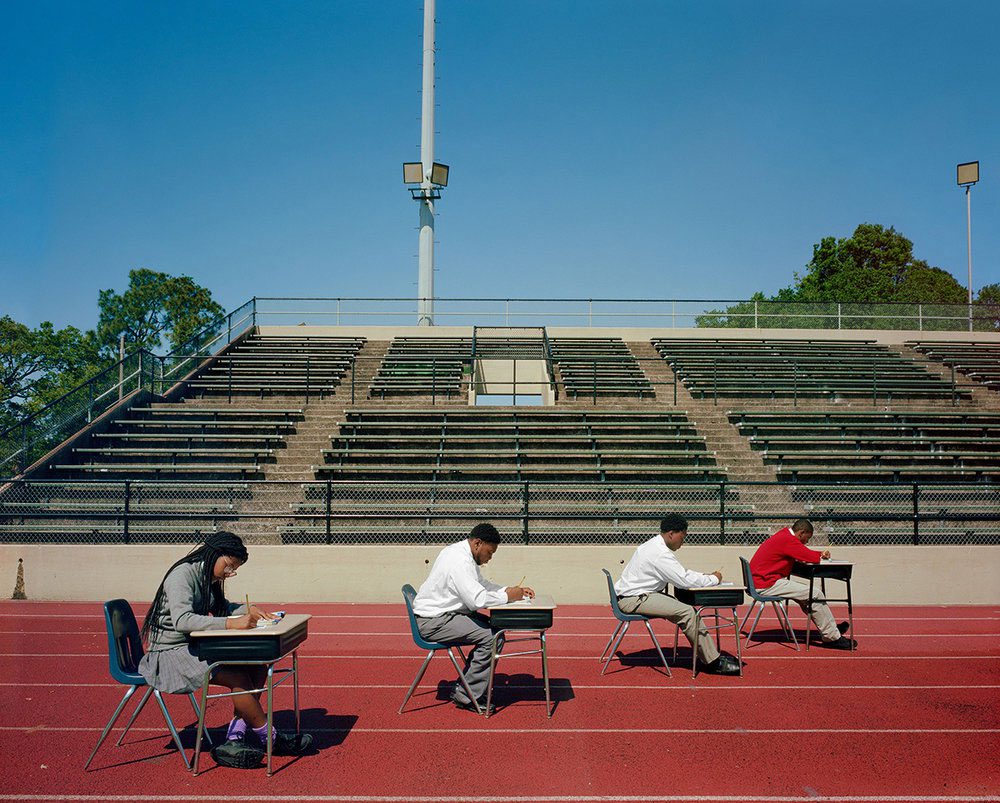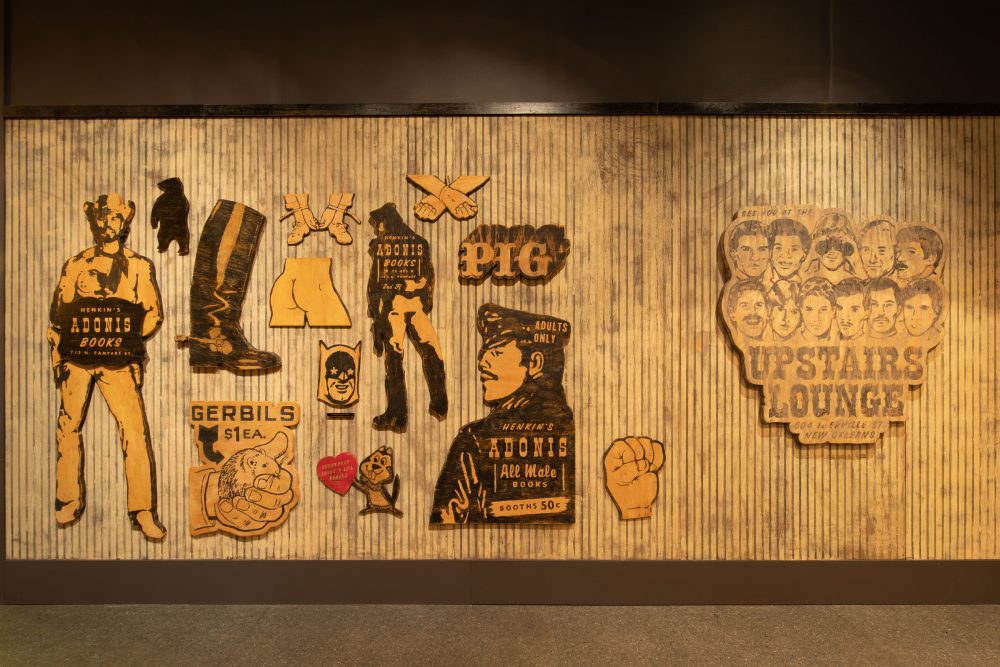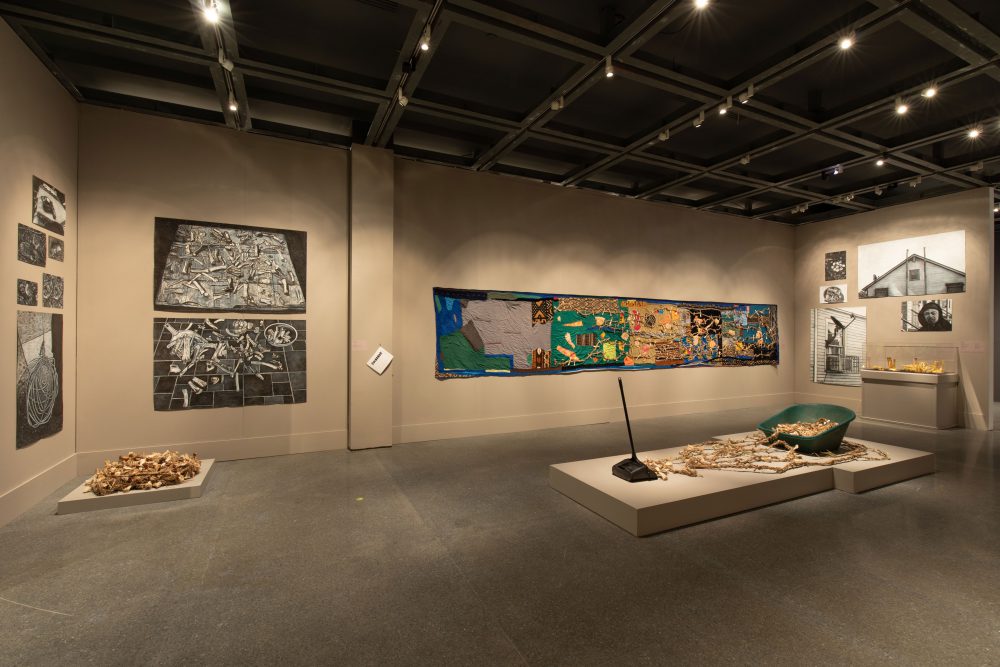For Us All: “Changing Course” at the New Orleans Museum of Art
Benjamin Morris visits the New Orleans Museum of Art’s tricentennial exhibition, which spotlights often overlooked parts of the city’s history.

L. Kasimu Harris, Race to the Top, 2018. Archival pigment print. Courtesy the artist.
Editor's Note
New Orleans is a small city, especially compared to the impact its culture has had on the rest of the United States—and the world. There are tight-knit groups of artists, curators, administrators, and critics living here, and oftentimes, a single person will fill many of those roles. At Pelican Bomb, we’ve always leaned into this proximity, understanding that this closeness is what makes our community so strong.
The New Orleans Museum of Art’s current exhibition “Changing Course: Reflections on New Orleans Histories” includes seven projects produced by a diverse group of artists, and trying to find a writer to cover the show without a perceived conflict of interest proved difficult. We turned to Benjamin Morris, a longtime contributor to the Art Review, for his expertise and dedication to supporting the arts in the city we call home.
Morris has previously collaborated with L. Kasimu Harris, whose photographs are on view in “Changing Course.” Katrina Andry, who created a new installation for the exhibition, previously served as Project Manager at Pelican Bomb. And you’ll find a portrait of our Editorial and Communications Manager Charlie Tatum among Willie Birch’s most recent works. Understanding that familiarity can be an asset, we present Morris’ review with these disclosures front and center.
Nine months into the celebration of New Orleans’ tricentennial, it is easy to feel as though the number 300 has now been plastered on every surface that can possibly receive it, from billboards to restaurant menus to conference titles to, yes, merchandise. The anniversary of the city’s founding (though not of its first settlement by Native American populations) has become far more than an occasion for historical remembrance or reflection—instead, it is now a marketing campaign intended to showcase the city’s offerings. Put more crudely, it is, and always was, a sales opportunity for the public. But which public? The people who live here or tourists visiting from outside? And once those tourists arrive, what kind of histories do they encounter from within the safe, glassed-in vistas of their tour buses or while stumbling tipsily down the streets of the Vieux Carré?
As if in response to these questions comes a major exhibition at the New Orleans Museum of Art. “Changing Course: Reflections on New Orleans Histories” challenges the easy, walking tour-ready accounts of the city’s past by presenting works addressing marginalized communities in the area. Featuring seven projects, primarily by local artists, “Changing Course” seeks to pull back the gilded curtain of the tricentennial to illuminate stories that might otherwise escape public notice during this celebration of New Orleans’ past and present. At turns bold, poignant, mournful, and defiant, these works refuse any casual assimilation into a cookie-cutter narrative of orderly growth and progress through time.
The exhibition opens in NOMA’s Great Hall with photographs by L. Kasimu Harris. In a series called War of the Benighted, Harris portrays local African-American high-school students engaged in surreptitious, at times directly subversive activities within the halls of their own educational institutions. At once critiquing destructive decisions in the city’s recent history—such as the firing of thousands of veteran teachers in the wake of Hurricane Katrina—as well as staging revolutionary acts of self-education, these images offer a powerful vision of learners taking their destinies in their own hands.
In War on the Benighted #5, 2018, students write names of black luminaries on a chalkboard, claiming their own heritage, as opposed to one imposed upon them by others. Similarly, multiple images depict the repurposing or recasting of space in new ways: McDonogh Day Boycott, 2018, references segregated ceremonies held until the 1950s wherein all public-school students, including Harris’ own mother, were required to pay homage to John McDonogh, the slave-owning patron of many local schools. In Harris’ image, however, students at their desks study subjects of their choosing; prominently displayed, along a clear compositional line aimed at McDonogh’s statue, is a biography of the Civil Rights activist Ella Baker.
In much of Harris’ work visual repetition plays a significant role, and this series is no exception. In Past Lessons Applied, 2018, the image invoking the post-Katrina firing of schoolteachers, a school building appears as an imposing force that dominates the composition. Yet the square brick front of the structure is echoed by the strong, flat, bared chest of the lead protester, a defiant masculinity that challenges the perceived inflexible wisdom of the “parent” institutions that have undermined their students’ opportunities to learn. Likewise, Race to the Top, 2018, features the rigid orthodoxy and harsh lines of bleachers in a stadium interrupted by the bodies of students studying at desks on the track. Here, the gentle drape of braided hair and the subtle curve of a student’s leg offer organic forms against the structured, constrained geometry of the architecture and furniture. Further, Harris upends racialized narratives of black success through athletic prowess by portraying the children on the field for intellectual achievement, not sports-related spectacle.

Installation view of Skylar Fein’s Remember the UpStairs Lounge, 2008, at the New Orleans Museum of Art. Courtesy the artist and Jonathan Ferrara Gallery, New Orleans. Photo by Roman Alokhin.
While Harris depicts vignettes of a narrative of conflict and reclamation that a viewer is invited to construct—against the backdrop of a school system that continues to struggle today—Skylar Fein’s invocation of history focuses on one specific event. His installation Remember the Upstairs Lounge, 2008, addresses the 1973 arson attack on the Upstairs Lounge, a prominent gay bar in the French Quarter, in which 32 people were killed.
Fein’s installation, which debuted at Prospect.1 in 2008, appears now on the 45th anniversary of the blaze. The case was never solved; moreover, as the work shows, despite being one of the deadliest arson attacks in American history, the event itself was largely ignored or suppressed in local news media given the bar’s queer constituency. While Fein’s installation has changed its layout since its original debut as a loose recreation of the original space (it is now compliant with ADA guidelines and better able to handle large crowds, for instance), it here retains its sense of deep history, with signs, posters, photographs, text, and reimagined marquees representing a visual and narrative record of the queer landscape of the day—signposts of a city now lost to time.
In that respect, Remember the Upstairs Lounge veers more toward a historical exhibit than other pieces in “Changing Course,” but through the anger and grief it bears, it firmly retains the biting edge of art. In its present format, a replica peep-show booth contains the 1973 CBS newsreel covering the fire, but it has been edited into a satirical, almost surreal loop. Perhaps the most pointed part of the installation, the peep-show here replaces titillation with horror and voyeurism with anguished outrage.
In the next room, Lesley Dill pays homage to one of New Orleans’ visionary artists, Sister Gertrude Morgan, who famously worked as a street preacher while producing paintings, drawings, music, and poetry. Featuring a mix of large-scale posters and banners with images and text alongside two hand-stitched dresses representing the two main phases of Morgan’s evangelistic career, Dill’s Hell Hell Hell/Heaven Heaven Heaven: Encountering Sister Gertrude Morgan & Revelation, 2010, surrounds the viewer with visions of apocalyptic worlds.
Most prominent in Dill’s installation is her wild, unruly text, featuring lettering in a range of colors, sizes, styles, and settings that jars the eye from beginning to end. The work contains a mixture of Morgan’s own words with scripture verses taken largely from the book of Revelation, sprinkled throughout with words of other poets and mystics. Such turbulent presentation serves a purpose, even though some viewers may find these passages difficult to read. Not only does it invoke the tradition of the illuminated manuscript, central to Biblical transmission over millennia, but it further serves to disturb the eye, reminiscent of the shocking, disruptive nature of the gospel narrative itself: Prophetic language tends to offend the present with news of the future, invoking what we cannot yet see in order to guide our actions towards repentance, reconciliation, or justice.
Among the strengths of “Changing Course” are the curatorial juxtapositions of its pieces, such as the contrast moving from Fein’s dusky, image-saturated record of the 1970s French Quarter to Dill’s bright maelstrom of letters and icons. Though only a few feet separate the installations, the mood shifts dramatically between them, a shift that arises again with the next piece: the 20-minute film The Living Need Light The Dead Need Music, 2014, by The Propeller Group, a video whose sounds bleed into every installation nearby. As in its debut at Prospect.3 in 2014, this film’s exploration of Vietnamese funeral traditions and their local counterparts remains a hallmark of sumptuous, haunting visuals, defying rational explication in favor of dreamlike immediacy and beauty. To see it in context with the other works at NOMA is to be reminded of New Orleans as a place of heightened sensuousness, wherein sensory overload is a celebrated aspect of its history. Hypnotic as ever, viewers should make sure to experience the film in full.

Installation view of works by Willie Birch at the New Orleans Museum of Art. Courtesy the artist. Photo by Roman Alokhin.
The last two installations in the show, Katrina Andry’s Diverge Divest Deny (repeat), 2018, and a large suite of drawings and mixed-media works by Willie Birch, round out the exploration of community in differing but complementary ways. Andry’s installation comprises 43 hand-printed panels depicting vegetation and overgrowth, mounted with pieces of scrunched styrene on which are printed planning documents and archival images from the destroyed Claiborne Avenue corridor, the shuttered Lincoln Beach amusement park, and areas of New Orleans East flooded during Katrina. Exploring the tension between what planners and developers call “progress” and what the communities they impact (here, primarily African-American residents and business owners) actually experience, Andry obscures these historic images by presenting them as crumpled sculptural forms. Such a gesture accomplishes two ends: It requires the acknowledgement that these histories have been overlooked, and furthermore it critiques how seemingly innocuous materials—e.g. paper and blueprints—can be used as tools of great harm, a local improvisation on what Hannah Arendt famously called “the banality of evil.”
If Andry is interested in community from a bird’s-eye view, however, then Birch prefers to scrutinize it directly on the ground. In nearly 40 charcoal and acrylic works on paper, Birch has created a real-time documentary of the city’s Seventh Ward: not a commodified zone for tourists, but a place where through his efforts to create an “art-centered community” he is working to nurture the culture that has made, and continues to make, New Orleans distinctive. He situates the majority of his subjects—neighbors and friends—in front of their houses or on their streets, wedding person to place in clear, plainspoken renderings.
In his mixed-media works, such as Collecting of the Bones, 2018, and the wall-sized tapestry For a Generation Not Yet Born: The Louisiana Slave Revolt of 1811, 2018, he employs materials such as sweetgrass and animal bones in new forms of symbolic assemblage, wherein bone frequently represents ancestors in Louisiana’s historic African-American communities. For Birch, bone is a primal element: totemic, metaphoric, and an agent of ritual and tradition. While in some works he has chosen to gild different bones, making them newly beautiful as a gift or homage, in most they are left unadorned—suggesting that in likening each bone to a member of his community these bones are already beautiful in just that respect and require no external embellishment. A dynamic presence across his many works, Birch’s careful, purposeful handling of bone allows its power to manifest in quiet yet compelling ways.
If “Changing Course” seeks to remedy past ignorance or marginalization of different communities in New Orleans’ history, the final gesture of the exhibition is one that seeks to explicitly open up the walls of the museum to new communities. The #EveryDayNewOrleans initiative, a local iteration of a global effort, has taken photographers into each of the 72 named neighborhoods in the city to conduct photography and visual literacy workshops, and brought images created by workshop participants in those neighborhoods back to the museum. Displayed on the walls of the central corridor in the geographic heart of the museum, these photographs offer voices and visions of the city by ordinary citizens independent of official narratives. Such attempts to increase the permeability of the museum’s walls are laudable, but how successful they are in the long-term (or how even to measure such success) remains an open question.
Rivers naturally change course over time, but what does it mean for a city to do the same? How long does it take, and who and what are the driving forces involved? In one respect, “Changing Course” seeks to address (if not remedy) the injustices of the past by offering an opportunity for marginalized communities to come together under one roof, and to champion the enduring aspects of their history—a hugely ambitious project whose ambition can and should be recognized. Whether a single exhibition can overturn three centuries is up for debate, but it is undeniable that within its spaces a fresh perspective emerges: a vision that foregrounds how easily communities can be overlooked by political, economic, and even mnemonic forces—and just how much the city stands to lose should this continue to be the case.
The question arises once more, then: who is the tricentennial of New Orleans for? Given how many of the works at NOMA directly engage the events or figures of the past, it is tempting to regard the show as a retrospective, but such an approach would miss the point. By telling the stories of the past, “Changing Course” is in fact far more concerned with the city’s future, what stories it will tell going forward, and how we not just as participants in but custodians of those stories can ensure that no community or history is disregarded. Doubtless, environmental crises threaten the whole of the Gulf Coast, and the prospects of a New Orleans quadricentennial may dim, but such concerns do not release its citizens from the obligations to shepherd the stories of all its people through time—without which there will be no city to visit, no culture to champion or remember. For all this city has meant to the world over the years, any anniversary of its founding should be a moment of celebration for us all.
Editor's Note
“Changing Course: Reflections on New Orleans Histories” is on view through September 16, 2018, at the New Orleans Museum of Art (1 Collins C. Diboll Circle).



